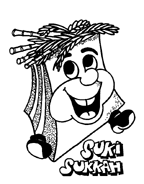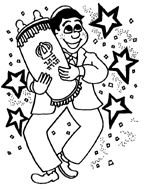© 1996-2025 TorahTots.com

SUKKOT
|
|
The Yom Tov of Sukkot
(rhymes with "Sue COAT," and in Yiddish, "Sukkos"
rhymes with "BOOK us,") begins at sundown of the 14th
day of Tishrei,
five days after Yom Kippur.
And what a change it is. We go from the most solemn day of the
year to one of the most joyous times.
This year (2025),
Sukkot, also called Zman Simchateinu, (the time
of our gladness), starts at sundown, Monday,
October 6, and lasts for seven days. Sukkot
is immediately followed by two separate Yomim Tovim (holidays),
Shemini Atzeret on Tuesday, October
14, and Simchat Torah on Wednesday,
October 15, but we commonly think of them as part of Sukkot.
In Eretz Yisroel, The
Yom Tov of Sukkot lasts for seven days followed
by one separate Yom Tov, - Shemini Atzeret / Simchat Torah on Tuesday, October
14.
|
|
MELACHA
(WORK) ON
SUKKOT
|
The
Yom Tov of Sukkot is mentioned in Vayikra, Parshat
Emor 23:34, in Bamidbar, Parshat Pinchos 29:12,
and in Devarim, Parshat Re'eh 16:13. No work is permitted
on the first and second days of the Yom Tov, and on the
last days, Shemini Atzeret and Simchat Torah.
The "work" prohibited
on Sukkot is the same as that prohibited on Shabbat,
except that cooking, baking, transferring fire and carrying, all
of which are forbidden on Shabbat, are permitted on Sukkot.
When Sukkot falls on Shabbat, all bets are
off, and all Shabbat restrictions must be observed.
Work is permitted on the intermediate
days, days 3 thru 7 (except Shabbat of course). The intermediate
days are called Chol Ha-Mo'ed. In Eretz Yisroel,
The first and last day of the Yom Tov, are days on which
no work is permitted. Work is permitted on the intermediate days,
days 2 thru 7 (except Shabbat of course).
|
ERUV
TAVSHILIN |
NOTE:
THIS DOES NOT APPLY TO THIS YEAR - SUKKOT 2025:
When Sukkot falls on Thursday and Friday, (as it did in the year 5785-2024), in order to be able to cook on Friday for Shabbat,
an Eruv Tavshilin is made.
It is usually forbidden to prepare food on Yom Tov for
another day, even for the Shabbat. However, if someone
began preparing food for Shabbat before Yom Tov, it is permitted to continue on Friday (even though
it is Yom Tov). This is known as 'Eruv Tavshilin,'
literally, 'mingling of cooked foods,' since these foods become
part of the Shabbat food, whose preparation has already
begun BEFORE the Yom Tov started, and may therefore be
continued on Friday.
Some food (a matzah and a cooked food, such
as an egg, fish or meat) is prepared on the afternoon before Yom
Tov (Wednesday), and set aside to be eaten on Shabbat.
When we set this food aside on Wednesday afternoon, we recite
the following blessing:
"Blessed are You, Hashem, our God, King of the universe, Who has
made us holy with His mitzvot, and commanded us about the
mitzvah of Eruv.'
We now explain why we are making an Eruv, so we say the
following paragraph. Someone who does not understand the text
should recite it in English:
"With this Eruv, may we be allowed to bake, to cook, to
fry, to insulate, to light a flame, to prepare for, and to do
anything needed on Yom Tov for the sake of Shabbat
[for ourselves and for all the Jews who live in this city]."
|
|
LET'S
BUILD
A
SUKKAH
|
NOTE:
This is just a very basic introduction. There are many complex
laws involved in the building of a Sukkah, and a competent
authority should be consulted with any questions.
 "Sukkot"
means "booths," and refers to the temporary dwellings
that Hashem commands us to live in during this Yom
Tov ( see Vayikra, Parshat Emor 23:42-43) as our
ancestors, the Bnei Yisroel wandered through the desert
for forty years, living in temporary shelters. "Sukkot"
means "booths," and refers to the temporary dwellings
that Hashem commands us to live in during this Yom
Tov ( see Vayikra, Parshat Emor 23:42-43) as our
ancestors, the Bnei Yisroel wandered through the desert
for forty years, living in temporary shelters.
A Sukkah should have four walls. The side of a building
can be considered a wall. The walls must be made from any material
that will withstand an ordinary wind. A commonly used material
here in the United States is canvas, tied or nailed down so that
it does not flap in the wind. The material may be borrowed, but
not stolen. The area of the Sukkah can be any size, so
long as it is large enough for you to fulfill the Mitzvah
of dwelling in it (the minimum size is approx. 23-28 inches by
23-28 inches.
The covering (roof) of the Sukkah, or the S'chach
(literally, covering) must be a material that grew from the earth,
was cut off from the earth, and not susceptible to Tumah
(contamination). This includes tree branches, corn stalks, bamboo
reeds, and sticks. But metals, leather, growing trees and foodstuffs
are excluded. S'chach must be left loose, not bundled
together or tied down. S'chach must be placed sparsely
enough that rain can get in, and preferably sparsely enough that
the stars can be seen, but not so sparsely that there is more
sunlight than shade, and not more than ten inches open at any
point. The S'chach must be put on last.
 It is a Mitzvah, and of course, a lot of fun, decorating
the Sukkah. A favorite decoration is drawings or charts
of the Ushpizin (guests), the seven eminent biblical
guests we invite to honor us by visiting our Sukkah.
They are: Avraham, Yitzchok,
Yaakov, Moshe,
Aharon, Yosaif
and Dovid.
It is a Mitzvah, and of course, a lot of fun, decorating
the Sukkah. A favorite decoration is drawings or charts
of the Ushpizin (guests), the seven eminent biblical
guests we invite to honor us by visiting our Sukkah.
They are: Avraham, Yitzchok,
Yaakov, Moshe,
Aharon, Yosaif
and Dovid.
Others hang live fruit like apples and grapes from the S'chach.
(Sit under them at your own risk). Bees like to visit the Sukkah
too. Honor the Sukkah by bringing in your finest utensils,
but never any pots and pans. A Sukkah must be treated
with respect.
|
|
TAYSHVU
K'AIN
TA'DURU
|
The
Mitzvah to "dwell" in a Sukkah means
to live there, and includes sleeping in the Sukkah. The
Talmud states, Tayshvu K'ain Taduru. ("Dwell in the Sukkah
as you would live in your home.") However, if the weather, climate,
and one's health precludes sleeping in the Sukkah, one
can fulfill the Mitzvah by simply eating all of one's meals
there. One should however, make an effort to live in the Sukkah
as much as possible, including sleeping in it.
|
|
ARBAH
MINIM - THE
FOUR
SPECIES
For sequence
of Lulav wavings, click here.
|
 The Torah commands us to "take for yourselves on
the first day (of the Sukkot Yom Tov),.... The Four Species."
(Except when Sukkot Falls on Shabbat).
The Torah commands us to "take for yourselves on
the first day (of the Sukkot Yom Tov),.... The Four Species."
(Except when Sukkot Falls on Shabbat).
The Arba Minim (Four Species) are the:
- Etrog (citron),
- Lulav (a date palm
branch),
- three Hadassim (myrtle
twigs), and
- two Aravot (willow
twigs).
We are commanded
to take these four plants and use them to "rejoice before
Hashem." The three branches are bound together
and referred to collectively as the Lulav.
 The
etrog is held in the left and the Lulav in the
right hand. With these four species in hand, one recites a Bracha
(blessing) and waves the species in all six directions (east,
south, west, north, up and down, symbolizing the fact that Hashem
is everywhere). The
etrog is held in the left and the Lulav in the
right hand. With these four species in hand, one recites a Bracha
(blessing) and waves the species in all six directions (east,
south, west, north, up and down, symbolizing the fact that Hashem
is everywhere).
For sequence of Lulav wavings, click here.
|
|
RING
AROUND
THE
BIMAH
|
The
four species are also held during the Hallel, a special
prayer in the morning Yom Tov services, and are held during
Hoshanot, a procession around the Bimah (the Table
from where the Torah is read) each day during the Yom
Tov. (Except on Shabbat).
These Hoshanot processions were made around the Mizbayach
(Altar) of the Bait Hamikdash in Yerushalayim.
The processions are called Hoshanot, because while the
procession is made, we recite a prayer with the refrain, "Hosha
Na!" (please help us!). On the seventh day of Sukkot,
seven circuits are made. For this reason, the seventh day of Sukkot
is known as Hoshanah Rabba (the great Hoshana).
|
|
SHEMINI
ATZERET
AND
SIMCHAT
TORAH
|
The
evening of the seventh day of Sukkot, (Hoshanah Rabba),
starts the Yom Tov called Shemini Atzeret. This
year (2025), Shemini Atzeret,
starts at sundown, Monday, October 13,
Tishrei 21.
In Eretz Yisroel, where
Shemini Atzeret is only one day,
(Tuesday, October
14, 2025, Tishrei 22), it is also the Yom
Tov of Simchat Torah. Outside of Eretz Yisroel,
it is the second day of Shemini Atzeret, (Wednesday,
October 15, 2025, Tishrei 23), that is the Yom
Tov of Simchat Torah.
As mentioned earlier, these
Yomim Tovim (holidays) are commonly thought of as part
of Sukkot, but that is not so; Shemini Atzeret
is a Yom Tov in its own right and does not involve the
special observances of Sukkot. (the four species and
Sukkah).
Shemini Atzeret literally
means "the assembly of the eighth (day)." Rabbinic literature
explains the Yom Tov this way: Hashem is like
a host, who invites us as visitors for a limited time, but when
the time comes for us to leave, He has enjoyed Himself so much
that He asks us to stay another day.
|
|
RING
AROUND
THE
BIMAH
AGAIN
|
The
last day of Yom Tov - Simchat Torah "(Rejoicing
in the Torah)" is the time we complete the annual cycle of
weekly Torah Parsha readings. We read the last Torah
portion, Devarim, Parshat V'zot Habracha, and then proceed
immediately to the first Parsha of Bereishit,
reminding us that the Torah is a circle, which never ends.
 This
completion of the readings is a time of great celebration for
all ages. There are processions called Hakafot around
the synagogue carrying Torahs and plenty of high-spirited
singing and dancing. Children come to Shul with their
own toy torahs and/or flags, and help celebrate by dancing
with their fathers. This
completion of the readings is a time of great celebration for
all ages. There are processions called Hakafot around
the synagogue carrying Torahs and plenty of high-spirited
singing and dancing. Children come to Shul with their
own toy torahs and/or flags, and help celebrate by dancing
with their fathers.
As many people as possible are given the honor of carrying a
Torah scroll in these Hakafot. For the reading
of Parshat Vzot Habracha, every male (including boys
under Bar Mitzvah age), are called to the Torah
for an Aliyah.
|
 Return
to SUKKOT Page
Return
to SUKKOT Page


Designed by R.A. Stone Design Associate
and
HI-TECH Computers, Inc.
(718) 253-9698
Email.... .info@hitechcomputers.com
Page last updated - 08/10/2025
|
|
Google ads
partially offset the costs of this site.
Email us ASAP if there are any
inappropriate ads, and we will request that they be
removed.
|







